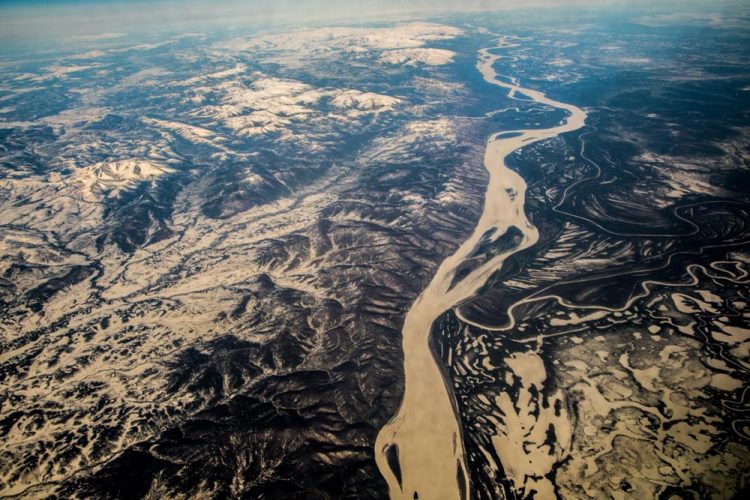Air temperatures in the Arctic are driving system change

The Yukon River winds through western interior Alaska in early April. UAF photo by Todd Paris
“The Arctic system is trending away from its 20th century state and into an unprecedented state, with implications not only within but beyond the Arctic,” according to lead author Jason Box of the Geological Survey of Denmark and Greenland in Copenhagen.
Several University of Alaska Fairbanks researchers are co-authors on the paper, which says that “increasing air temperatures and precipitation are drivers of major changes in various components of the Arctic system.”
The study is the first to combine observations of physical climate indicators, such as snow cover, with biological impacts, such as a mismatch in the timing of flowers blooming and pollinators working.
Climate indicators are key pieces of information that capture the essence of a system, according to Walsh. An example would be September sea ice extent, which summarizes the effects of things like temperature, winds, ocean heat and other variables.
“I didn't expect the tie-in with temperature to be as strong as it was,” Walsh said. “All the variables are connected with temperature. All components of the Arctic system are involved in this change.”
“Never have so many Arctic indicators been brought together in a single paper,” he said.
The authors correlated records of observations from 1971 to 2017 of nine key indicators: air temperature, permafrost, hydroclimatology, snow cover, sea ice, land ice, wildfires, tundra and terrestrial ecosystems, and carbon cycling. All the indicators correlate with rising temperatures, pointing to a warming climate and a fundamental change in the Arctic.
“The Arctic system is trending away from its 20th century state and into an unprecedented state, with implications not only within but beyond the Arctic,” according to lead author Jason Box of the Geological Survey of Denmark and Greenland in Copenhagen.
“Because the Arctic atmosphere is warming faster than the rest of the world, weather patterns across Europe, North America and Asia are becoming more persistent, leading to extreme weather conditions. Another example is the disruption of the ocean circulation that can further destabilize climate: for example, cooling across northwestern Europe and strengthening of storms,” said Box.
The paper is the flagship piece in a special issue on Arctic climate change indicators published by the journal Environmental Research Letters. IARC's Igor Polyakov is lead editor for this special issue, which has other papers co-authored by UAF scientists. In addition to Walsh, the authors include the Geophysical Institute's Uma Bhatt and Vladimir Romanovsky, and Eugénie Euskirchen of the Institute of Arctic Biology, along with many international colleagues.
The authors of the study hope that these indicator-based observations provide a foundation for a more integrated understanding of the Arctic and its role in the dynamics of the Earth's biogeophysical systems.
###
ON THE WEB: The paper is available online at https:/
Video available at https:/
Media Contact
All latest news from the category: Earth Sciences
Earth Sciences (also referred to as Geosciences), which deals with basic issues surrounding our planet, plays a vital role in the area of energy and raw materials supply.
Earth Sciences comprises subjects such as geology, geography, geological informatics, paleontology, mineralogy, petrography, crystallography, geophysics, geodesy, glaciology, cartography, photogrammetry, meteorology and seismology, early-warning systems, earthquake research and polar research.
Newest articles

High-energy-density aqueous battery based on halogen multi-electron transfer
Traditional non-aqueous lithium-ion batteries have a high energy density, but their safety is compromised due to the flammable organic electrolytes they utilize. Aqueous batteries use water as the solvent for…

First-ever combined heart pump and pig kidney transplant
…gives new hope to patient with terminal illness. Surgeons at NYU Langone Health performed the first-ever combined mechanical heart pump and gene-edited pig kidney transplant surgery in a 54-year-old woman…

Biophysics: Testing how well biomarkers work
LMU researchers have developed a method to determine how reliably target proteins can be labeled using super-resolution fluorescence microscopy. Modern microscopy techniques make it possible to examine the inner workings…





















